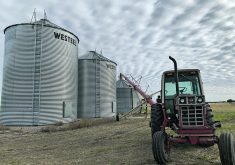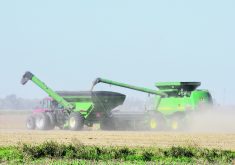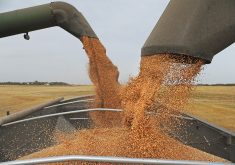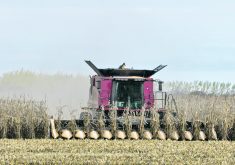MANITOBA
The last few acres of greenfeed, millet, barley and oats remain to be seeded across the province. As well, many spring seeded crops are being reseeded because of soil crusting, insect activity and disease.
Southwest
Seeding in the far south is nearly complete, while farmers across the region continued spraying work. Along the U.S. border, there is surplus moisture, but recent rain in other spots were welcomed. Hail was reported but caused little damage.
Producers are fighting flea beetles in canola. Cutworm damage is noted in the Birtle, Rossburn, Strathclair and Hamiota areas.
Read Also

Saskatchewan dairy farm breeds international champion
A Saskatchewan bred cow made history at the 2025 World Dairy Expo in Madison, Wisconsin, when she was named grand champion in the five-year-old Holstein class.
Northwest
Cool temperatures and storms slowed herbicide applications. Soil moisture is generally adequate.
Cereals and canola are progressing, with the most advanced development in the Roblin, Russell and Swan River areas.
There has been some flea beetle spraying, and there are reports of cutworms, although insect counts in canola fields are low.
Central
Broadcast seeding has allowed for progress in the wettest parts of the region, which have seen as much as 15 millimetres of rain and some hail.
Crusting is an issue in some areas, and some soybean and canola crops may need to be reseeded.
Leaf disease is present in fields with cereal stubble from last year, and some cereals, including oats, have been reseeded because of rot.
Cutworms are reported in corn and broadleaf crops. Diamondback moth counts are the highest in the eastern part of the region.
Many canola fields have received first herbicide applications.
Flea beetles are a concern. Applications have also been made to corn and soybean crops.
Eastern
Seeding is complete, although there’s surplus soil moisture in some areas following a storm that brought winds and hail, damaging fields in the Tyndall, Garson, Beausejour, Anola and Elma areas.
Seed rot in soybeans and seedling disease in spring cereals are reported.
Producers are making herbicide applications, and some fields require a second application. Growers have started fungicide applications in winter wheat fields.
Interlake
Seeding is complete, and crops are advancing well with a mix of rain and warmer temperatures.
Cereals range from the two to six leaf stage and canola is approaching the four leaf. Corn crops are reported at the two to five leaf stage.
Most field conditions are good, and farmers are making herbicide applications.
SASKATCHEWAN
Seeding is virtually complete.
Rain has delayed spraying work, with some spots receiving more than 100 mm. Crop conditions are generally rated as fair to excellent with adequate soil moisture.
Southeast
Rain delayed the last of seeding, which remains ahead of the five-year average. Spraying has also been delayed.
The Bengough area received the most rain since spring — nearly 220 mm — and growers are now looking for warm weather to assist crops.
Producers are spraying for flea beetles, which have reached economic thresholds in northern parts of the region.
Some producers in the southwest are spraying for cutworms in canola fields, and there are reports of significant damage from flea beetles.
Central
Most spots in the region have received rainfall in June, with precipitation in the Major area now exceeding 100 mm since April 1.
There are concerns about weeds in wet fields in the east-central portion of the region. Some growers are spraying for flea beetles in canola fields, and there are reports of damage from both flea beetles and cutworms in canola crops in the west-central areas.
North
The region has received significant rain this month, with many areas receiving more than 60 mm.
There is excess topsoil moisture on most cropland and hay land in the northeast, while the western portion fares better.
There are reports of localized flooding and damage from flea beetles and cutworms. In the northwest, grasshoppers are reported.
ALBERTA
Recent rain brought more than 100 mm of water to some areas.
Crops are generally off to a positive start and topsoil conditions are good in most parts of the province, although excessive rain caused significant flooding issues in southern Alberta. Saturated fields will be an issue in other spots.
Pests haven’t been a major concern for growers, who are largely focused on weed control.
South
Growers will be assessing crops following heavy rain and flooding in southern Alberta.
Cutworms haven’t been a problem, but cereal leaf beetles in barley and spring wheat crops will require spraying across a wide portion of the region.
Central
Crop condition ratings are down in the western half of the region from last year because of moisture but are otherwise above average.
There have been reports of cutworms in canola crops, although none at economic thresholds requiring spraying.
Northeast
Soil moisture ratings have improved with rain, although crop development has been slowed by cool temperatures, which combined with a dry spring are affecting hay and pasture conditions.
Northwest
Cool temperatures have slowed crop growth.
Peace
Standing water is a concern in some spots, with some locations receiving as much as 125 mm of rain this month.
Spring cereals are in the mid tillering stage, and hay and pasture conditions are rated as excellent.














